Articles
- Page Path
- HOME > J Korean Powder Metall Inst > Volume 24(5); 2017 > Article
-
ARTICLE
- Influence of milling atmosphere on thermoelectric properties of p-type Bi-Sb-Te based alloys by mechanical alloying
- Suk-min Yoon, Cheenepalli Nagarjuna, Dong-won Shin, Chul-hee Lee, Babu Madavali, Soon-jik Hong*, Kap-ho Leea,*
-
Journal of Korean Powder Metallurgy Institute 2017;24(5):357-363.
DOI: https://doi.org/10.4150/KPMI.2017.24.5.357
Published online: September 30, 2017
Division of Advanced Materials Engineering, Kongju National University, Cheonan 331-717, Republic of Korea
a Department of Materials Science & Engineering, Chungnam National University, Daejeon 305-764, Republic of Korea
-
*Corresponding Author: Kap-ho Lee, +82-42-821-6291, +82-42-822-5850, kapho@cnu.ac.kr
*Co-Corresponding Author: Soon-Jik Hong, +82-41-521-9387, +82-41-568-5776, hongsj@kongju.ac.kr
• Received: October 16, 2017 • Revised: October 23, 2017 • Accepted: October 24, 2017
© The Korean Powder Metallurgy Institute. All rights reserved.
- 1,056 Views
- 4 Download
- 7 Crossref
Abstract
- In this study, Bi-Sb-Te thermoelectric materials are produced by mechanical alloying (MA) and spark plasma sintering (SPS). To examine the influence of the milling atmosphere on the microstructure and thermo-electric (TE) properties, a p-type Bi-Sb-Te composite powder is mechanically alloyed in the presence of argon and air atmospheres. The oxygen content increases to 55% when the powder is milled in the air atmosphere, compared with argon. All grains are similar in size and uniformly, distributed in both atmospheric sintered samples. The Seebeck coefficient is higher, while the electrical conductivity is lower in the MA (Air) sample due to a low carrier concentration compared to the MA (Ar) sintered sample. The maximum figure of merit (ZT) is 0.91 and 0.82 at 350 K for the MA (Ar) and MA (Air) sintered samples, respectively. The slight enhancement in the ZT value is due to the decrease in the oxygen content during the MA (Ar) process. Moreover, the combination of mechanical alloying and SPS process shows a higher hardness and density values for the sintered samples.
- The capable of converting thermal gradients into electrical energy is an attractive property in thermo-electric materials, owing to advantages for the application of power generation, refrigeration and energy harvesting from the exhausted heat [1]. Nowadays, a waste heat was increased by the automobiles, industries, electronic devices, and increasing human activities in day to day life [2]. For utilizing this obtained waste heat, high efficiency thermoelectric materials should be prepared. Among the different materials, bismuth telluride based alloys are the suitable thermoelectric materials near the room temperature range. So far the conversion efficiency of these materials is below 10~15%, which has been restricted to use in a wide range of practical applications [3-5]. The potential of a thermoelectric materials is evaluated by the dimensionless figure of merit ZT= [S2σ/K]T, where S is the Seebeck coefficient, σ is electrical conductivity, T is the absolute temperature and K is the total thermal conductivity [6]. Considering, highly efficient thermoelectric material, it should require high electrical conductivity, large Seebeck coefficient and low thermal conductivity [7, 8]. In order to intensify the performance of thermoelectric materials numerous methods have been employed to produce as high efficiency devices.
- Generally, the single crystal thermoelectric materials are produced by a different crystal growth methods such as zone melting, Bridgeman and Czochralsky [9-11] by adopting these techniques have some difficulties, which includes a time consuming process and the mechanical properties show poor due to the coarse grain size and weak Vander Waals bonds between the Te (1) -Te (1) layers [12]. Hence, to overcome these difficulties, currently researchers looking into a different powder metallurgical processes have been employed [13, 14]. Apart from this, Gas atomization (GA) is the fully known process to produce a large amount of metal or alloy powders in a short time [15]. The GA process offers to produce powders in a very fine size, spherical shape and wide range of particle distribution. The recent studies showing the enhanced thermoelectric and mechanical properties by the combination of gas atomization and spark plasma sintering [16].
- In addition, the mechanical alloying is a well known solid state powder processing technique which has been used extensively in the fabrication of thermoelectric materials owing to advantages for the refinement of powder particles into nanoscale level [17]. During the milling process, many factors could be an influence on the microstructure and thermoelectric properties of materials, such as milling atmosphere, milling time, intensity of rotation, milling media and vessels. However, if the vail was not sealed properly usually air goes inside the vial and the contamination will take place at the powder. So, we should avoid the oxidation and contamination effects on powder the milling was performed in an inert gas. Besides, the SPS is a widely used sintering technique for the compacting powders, due to lacking of grain growth during the sintering, lower sintering temperature, rapid heating rate and less holding time [18]. Kim et al. obtained a ZT of 0.7 for the reduced Bi-Te-Se alloy powder produced by ball milling and SPS process [19].
- In this study, we investigate the influence of milling atmosphere on thermoelectric properties of Bi-Sb-Te bulks, produced by high energy ball milling and SPS process. From this we have observed thermoelectric properties were slightly enhanced in the argon milled sample because of decreasing oxygen content.
Introduction
- Firstly, the high Purity elements of (99.999%) Bi, Sb and Te were (Commercially purchased from Alfa Aesar Co. Ltd) weighed according to the stoichiometric ratio to achieve Bi0.5Sb1.5Te3 alloy. The components of alloy powders were produced by the gas atomization (GA) process. The procedure of the gas atomization process was discussed in our previous report [2]. Then the atomized powders were mechanical alloyed with planetary ball milling equipment. Zirconia jars and balls were used as milling media and the ball to powder weight ratio was taken as 10:1 for 30 minutes with a speed of 800rpm. The mechanical alloying was performed under the presence of argon MA(Ar) and air MA(Air) atmospheres respectively. The mechanical alloyed powders were consolidated by using the Spark plasma sintering at 673 K under an axial pressure of 50 MPa in the vacuum state, the heating rate was raised 50 K /min and the holding time for sintering is 10 min. After the mechanical alloying, oxygen content in the powder state was analyzed with Eltra ONH-2000 Oxygen/Nitrogen/hydrogen determinator and the particle size distribution was observed by Master size 2000 particle size analyzer. The crystal structure of powder was analyzed by using the X-ray diffraction technique (Rigaku diffractometer, Miniflex-600, Japan with CuKα radiation with a wavelength of λ= 0.15418 nm). Densities of bulk sample were measured by Archimedes principle and Vickers hardness for the sintered samples were measured by the micro Vickers hardness tester. The morphology of powder characterized by Scanning electron microscopy (SEM) and composition analysis of sintered samples was observed by SEM equipped with EDS. Thermo-electric properties of bulk samples were measured from the room temperature to 500K using the thermoelectric power measurement system (TEP 1000). For measuring Seebeck coefficient and electrical conductivity of bulk samples were cut into a rectangular shape (3 × 3 × 12 mm3). Carrier concentration and mobility were measured by using a Hall effect measurement system (Ecopia HMS-3000). The thermal diffusivity and heat capacity were measured using the laser flash method (Netzsch LFA 457 system). Thermal conductivity (K) was calculated by substituting the density (D), specific heat (Cp) and thermal diffusivity (λ) using the equation K= λCpD. Finally, the ZT values calculated from the obtained power factor and thermal conductivity values.
Experimental procedure
- Figure 1(a-d) Show the SEM micrographs of the p-type Bi0.5Sb1.5Te3 alloy powder were mechanical alloyed in an argon and air atmospheres. The initial spherical (GA) powder were carried out for ball milling and it changed into irregular shape. The particle sizes ranging from 3- 5 μm which is almost similar in both the atmosphere milled powders. However, morphologically we could not find any changes by milling atmosphere. The Particle size distribution of p-type Bi0.5Sb1.5Te3 powders milled under argon (Ar), and air mospheres as can be seen in fig 2 (a). After the mechanical alloying, all the powder particles show the size ranging from 0.1 μm to several tens of micrometers, and the average particle size range in MA(Ar) and MA(Air) atmospheres of 3.801μm and 3.878 μm respectively. The largest volume fraction of alloyed powders in both the atmospheres was found to be ̴7 Vol% was in between 1-10 μm diameter. Fig 2 (b) shows the oxygen content of p-type Bi0.5Sb1.5Te3 alloy powders milled under the presence of argon and air atmospheres. The oxygen content of 312 ppm and 483 ppm was observed in MA(Ar) and MA(Air) atmospheres respectively. Usually, the higher oxygen content was obtained in the MA(Air) powder due to the vessel filled in the air atmosphere.
- Fig 3 shows the XRD patterns of the as-prepared Bi0.5Sb1.5Te3 alloy powders were mechanical alloyed argon and air atmospheres. From this analysis, All the diffraction peaks are indicated as single phase having a rhombohedral crystal structure with space group (R3m). In both the atmospheres the diffraction peaks are well matched with the standard diffraction data (JCPDS:491713). And, therefore no distinct changes were observed in the alloys powders.
- The Elemental analysis conducted by using EDS map- ping for the MA(Ar) and MA(Air) sintered samples as can be seen in fig 4(a, b). From this we have observed all the components Bi, Sb and Te were uniformly distributed in the BST matrix. Additionally, the higher oxygen content was obtained in the MA(Air) sample which is mainly coming from the milling process. The Grain sizes were similar and their distribution was uniform in the two atmospheric samples.
- Table 1 shows the mechanical properties of p-type Bi0.5Sb1.5Te3 alloy powders of MA(Ar) and MA(Air) sintered samples. The relative densities were obtained more than 99% for both the samples and higher micro hardness values of 113 Hv and 117 Hv were obtained for the MA(Ar) and MA(Air) sintered samples respectively. The higher hardness and density values would prevent the cracks in TE modules, to resist the thermal stresses and mechanical vibrations during their operating time.
- Fig 5(a) shows the temperature dependence of the Seebeck coefficient for the p-type Bi0.5Sb1.5Te3 alloy samples were measured in the temperature range of 300- 500 K. All the properties were measured in the perpendicular to pressing direction. The positive Seebeck coefficient values exhibits over the temperature range of the two samples, which confirms that the samples are p-type semiconductors and the majority charge carriers are holes. The Seebeck coefficient values of sintered samples increase with increasing temperature up to a 350 K and then decreases with further rise in temperature, which is mainly due to the excitation of minority carriers. The higher Seebeck coefficient was obtained for the MA(Air) sintered sample than MA(Ar) sample, which is due to the decrease in carrier concentration of MA(Air) sample. For a degenerate semiconductor the Seebeck coefficient can be expressed as
- Where KB is the Boltzmann constant, e is the charge carrier, h is the planks constant, m* is the effective mass and T is the absolute temperature. As we know the relation of Seebeck coefficient is inversely proportional to the carrier concentration this relation can be seen in eq (1). Thus, the decrement in the carrier concentration would enhaced the Seebeck coeffeicnt values in air atmosphere. The temperature dependence of electrical conductivity (σ) for the ternary Bi0.5Sb1.5Te3 alloy samples was plotted in fig. 5(b). The electrical conductivity of MA(Ar) and MA(Air) sintered samples decreases with increasing temperature, which behavior indicating a metallic or degenerate semiconductor nature. In general, electrical conductivity (σ) is directly proportional to the carrier concentration (nc) and mobility (μ), and the corresponding relationship can be expressed as
- Where e is the electronic charge, μ is the charge carrier mobility and nc is the carrier concentration. At room temperature the electrical conductivity values of 494 (/Ωcm) and 427 (/Ωcm) were obtained in MA(Ar) and MA(Air) sintered samples respectively. The maximum electrical conductivity was obtained for the MA(Ar) sintered sample due to the high carrier concentration. Fig 5(c) shows the power factor values of the p-type Bi0.5Sb1.5Te3 alloy samples were measured as a function of temperature. At room temperature the maximum power factor was obtained for the MA(Ar) sintered sample than MA(Air) sample which, mainly accounts for the increasing of electrical conductivity. The largest power factor values 2.8 mW/mK2 and 2.6 mW/mK2 were obtained for the MA(Ar) and MA(Air) sintered samples respectively.
- To know the influence of milling atmosphere on the sign and density of charge carriers of p-type Bi0.5Sb1.5Te3 sintered samples, hall measurements were performed to obtain their carrier concentration and mobility as can be seen in fig 6(a, b).
- Where e, n and RH is the electronic charge, carrier concentration and hall coefficient respectively. The carrier concentration of the MA(Air) sample shows lower value than the MA(Ar) sample. At room temperature the carrier concentration values of 1.3 × 1019/cm3 and 1.0 × 1019/ cm3 were obtained for the MA(Ar) and MA(Air) samples respectively. These values are increased with measuring temperature due to the generation of antisite defects by the occupation of Te sites with Bi and Sb [20]. The mobility was decreased with measuring temperature due to the high carrier scattering. The MA (Air) sample shows high carrier mobility than MA (Ar), which is good agreement with the eq (2).
- The temperature dependence of thermal conductivity of p-type Bi0.5Sb1.5Te3 sintered samples was plotted in fig 7 (a). The origin of thermal conductivity comes from the two main sources via the charge carriers (either electrons or holes) and the phonans transports heat through the lattice (K=Ke+KL). The phonanic contribution is known to be strongly affected to reduce the total thermal conductivity than the electronic contribution at the grain boundaries. According to Wiedemann-Franz law, the electronic thermal conductivity is directly proportional to electrical conductivity times to absolute temperature, i.e Ke = L0σT Where L0 is the Lorentz constant L0 = 2.45 × 10-8V2K-2 for degenerate semiconductors. At room temperature the thermal conductivity (k) values shown approximately similar for both the samples. But with a rise in temperature thermal conductivity values were increased greatly, which might be due to the increase of lattice thermal conductivity at higher temperatures. However, MA(Ar) sintered sample shown significantly lower k value than the MA(Air) sample throughout the measuring temperature. The lowest K value has been observed 0.911 W/mK at 350 K for the MA(Ar) sample. The obtained K values are smaller than the other studies [21, 22]. The temperature dependence of the thermoelectric figure of merit (ZT) for the p-type Bi0.5Sb1.5Te3 alloy samples was plotted in fig 7(b). The maximum ZT values of 0.91 and 0.82 were obtained at 350K for the MA(Ar) and MA(Air) sintered samples respectively. The slightly enhancement in the ZT value for the MA(Ar) sintered milled sample, it was mainly ascribed to the significant reduction in thermal conductivity and enhanced power factor of MA(Ar) sample. In this work MA(Ar) sample shows a little higher performance than the MA(Air) sample. Hence, our results suggested that the MA (Ar) is an effective method for reducing oxygen content in the alloyed powders, which leads to enhance their thermoelectric properties.
Results and Discussion
Fig. 1
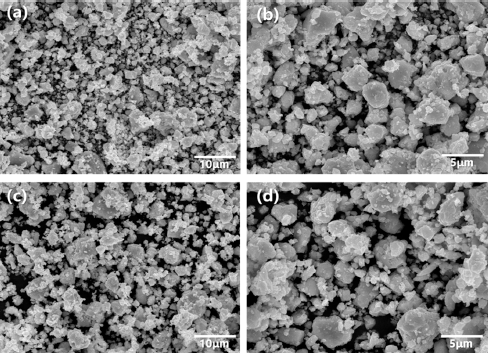
The surface morphology of p-type Bi0.5Sb1.5Te3 alloy powder by mechanical alloying in (a) argon and (c) air atmospheres respectively. The figures (b), and (d) are the corresponding high magnification images.

Fig. 2

(a) Particle size distribution and (b) oxygen content analysis of the p-type Bi0.5Sb1.5Te3 alloy powder milled in argon and air atmospheres.

Fig. 3
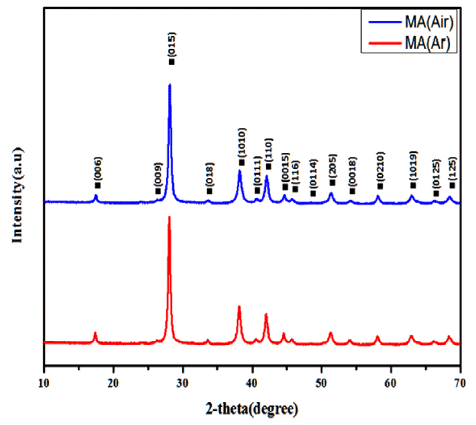
X-ray diffraction patterns of p-type Bi0.5Sb1.5Te3 alloy powder milled in an argon and air atmospheres.

Fig. 4
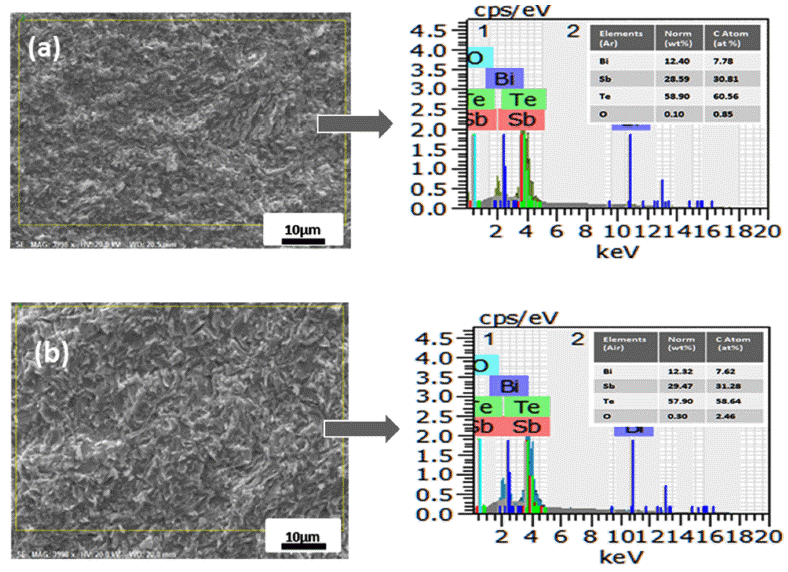
EDS mapping showing the Bi, Sb, Te distribution and oxygen concentration of the p-type Bi0.5Sb1.5Te3 alloy powder milled in argon (a) and air (b) atmospheres.

Table 1
Relative density and Vickers hardness of p-type Bi0.5Sb1.5Te3 alloy samples produced by MA and SPS
| samples | Density (100%) | Vickers hardness (Hv) |
|---|---|---|
|
|
||
| Argon atmosphere (Ar) | 99.86 | 113 |
| Air atmosphere (Air) | 99.4 | 117 |
Fig. 5

The temperature dependence of p-type Bi0.5Sb1.5Te3 alloys (a) Seebeck coefficient (b) Electrical conductivity and (c) Power factor of samples milled in the air and argon atmospheres.

Fig. 6
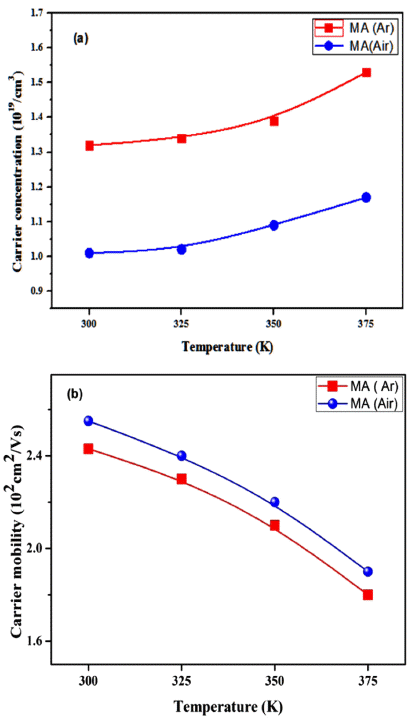
The temperature dependence of transport properties of (a) Carrier concentration and (b) mobility of P type Bi0.5Sb1.5Te3 bulk samples produced by MA and SPS

- In summary, we have successfully prepared p-type Bi0.5Sb1.5Te3 alloy powder through mechanical alloying under the presence of argon and air atmospheres. The effects of oxygen content on thermoelectric and mechanical properties were investigated. The higher oxygen content was observed in the MA (Air) sample. Microstructure analysis revealed that, all the grains are similar size and uniformly distributed in the two atmospheric sintered samples. The thermoelectric properties were slightly enhancd in the MA(Ar) sample due to low oxygen concentration. Electrical conductivity was increased and low thermal conductivity 0.911 W/mK was obtained for the MA(Ar) sintered sample. As a result, the maximum figure of merit (ZT), 0.91 was obtained at 350K for MA (Ar) sintered sample. Relative density show more than 99% and high hardness values obtained for two atmospheric sintered samples.
Conclusion
-
Acknowledgements
- This work was supported by the research fund of Chungnam National University in 2016.
Acknowledgement
- 1. C. Kim, D.H. Kim, Y.K. Lee, J.T. Kim, Y.S. Han and H. Kim: J. Alloys Compd.., (2014) 584 108.Article
- 2. P. Dharmaiah, H.S. Kim, C.H. Lee and S.J. Hong: J. Alloys Compd.., (2016) 686 1.Article
- 3. S. Miura, Y. Sato, K. Fukuda, K. Nishimura and K. Ikeda: Mater. Sci. Eng. A., (2000) 277 244.Article
- 4. M.S. Dresselhaus, G. Chen, M.Y. Tang, R.G. Yang, H. Lee, D.Z. Wang, Z. Ren, J.P. Fleurial and P. Gogna: Adv. Mater.., (2007) 19 1043.ArticlePDF
- 5. G.J. Snyder and E.S. Toberer: Nature., (2008) 7 5.
- 6. K.C. Park, P. Dharmaiah, H.Y. Kim and S.J. Hong: J. Alloys Compd.., (2017) 692 573.Article
- 7. L.E. Bell: Science., (2008) 321 1457.Article
- 8. K.H. Lee, H.S. Kim, S.I. Kim, E.S. Lee, S.M. Lee, J.S. Rhyee, J.Y. Jung, I.H. Kim, Y. Wang and K. Koumot: J. Electron. Mater.., (2012) 41 1165.ArticlePDF
- 9. O. B. Sokolov and S. Ya. Kipidarov: Crys. Growth., (2000) 236 181.Article
- 10. M.H. Ettenberg, S.J. Maddux, J. Taylor, W.A. Jesser and F.D. Rosi: J. Cryst. Growth., (1997) 179 495.Article
- 11. V.S. Zemskov, A.D. Belaya, U.S. Beluy and G.N. Kozhemyakin: J. Cryst. Growth., (2000) 212 161.Article
- 12. Z. Wanga, A. Vemishettia, J. I. Ejembia, G. Weia, B. Zhagb, L. Wangb, Y. Zhangb, S. Guob, J. Luoc, C. Chepkod, Q. Daid and J. Tangd: Mater. Sci. Eng. B., (2016) 205 36.
- 13. B. Poudel, Q. Hao, Y. Ma, Y.C. Lan, A. Minnich, B. Yu, X. Yan, D.Z. Wang, A. Muto, D. Vashaee, X.Y. Chen, J.M. Liu, M.S. Dresselhaus, G. Chen and Z. Ren: Science., (2008) 320 634.Article
- 14. M. Scheele, N. Oeschler, K. Meier, A. Kornowski, C. Klinke and H. Weller: Adv. Funct. Mater.., (2009) 19 3476.Article
- 15. B. Madavali, H.S. Kim, K.H. Lee, Y. Isoda, F. Gascoin and S.J. Hong: Mater. Des.., (2016) 112 485.Article
- 16. K.C. Park, P. Dharmaiah, H.S. Kim and S.J. Hong: J. Alloys Compd.., (2017) 692 573.Article
- 17. J. Jiang, L. Chen, Q. Yao and Q. Wang: Mater. Trans.., (2005) 46.
- 18. H.S. Kim and S.J. Hong: J. Alloys Compd.., (2014) 586 428.
- 19. K.T. Kim, T.S. Lim and G.H. Ha: Adv. Mater. Sci.., (2011) 28 196.
- 20. S. Seo, Y. Jeong, M.W. Oh and B. Yoo: J. Alloys Compd.., (2017) 706 576.Article
- 21. D.H. Kim, C. Kim, S.H. Heo and H. Kim: Acta Mater.., (2011) 59 405.Article
- 22. Z. L. Wang and T. Akao: J. Alloys Compd.., (2016) 663 134.Article
Figure & Data
References
Citations
Citations to this article as recorded by 

- Grain Size‐Dependent Thermoelectric Performances of Al2O3 Addition into BiSbTe Alloy During Heat Treatment Fabricated by Mechanical Alloying
Ji‐Won Ha, Vasudevan Rathinam, Eun‐Ha Go, Soon‐Jik Hong
Advanced Engineering Materials.2025;[Epub] CrossRef - Revealing the improved thermoelectric performances of (BiSb)2Te3 alloy through rapid solidification of cold-water assisted water atomization approach
Eun-Ha Go, Rathinam Vasudevan, Ji-Won Ha, Sung-Jae Jo, GeonWoo Baek, Soon-Jik Hong
Journal of Alloys and Compounds.2025; 1010: 177548. CrossRef - Microstructural and Thermoelectric Properties of Heat-treated Al2O3 Doped BiSbTe Alloy
Jiwon Ha, Vasudevan Rathinam, Eunha Go, Soonjik Hong
Journal of the Japan Society of Powder and Powder Metallurgy.2025; 72(Supplement): S983. CrossRef - Advancement of thermoelectric performances through the dispersion of expanded graphene on p-type BiSbTe alloys
Eun-Ha Go, Rathinam Vasudevan, Babu Madavali, Peyala Dharmaiah, Min-Woo Shin, Sung Ho Song, Soon-Jik Hong
Powder Metallurgy.2023; 66(5): 722. CrossRef - Influence of milling atmosphere on the structure and magnetic properties of mechanically alloyed Fe40Co30Ni30
Alex Abraham Paul, Anuj Rathi, Ganesh Varma Thotakura, Tanjore V. Jayaraman
Materials Chemistry and Physics.2021; 258: 123897. CrossRef - Enhancement of mechanical properties and thermoelectric performance of spark plasma sintered P-type Bismuth Telluride by powder surface oxide reduction
Ahmed A. Abdelnabi, Vickram Lakhian, Joseph R. McDermid, Yu-Chih Tseng, James S. Cotton
Journal of Alloys and Compounds.2021; 858: 157657. CrossRef - Solid solution evolution during mechanical alloying in Cu-Nb-Al compounds
Kaouther Zaara, Mahmoud Chemingui, Virgil Optasanu, Mohamed Khitouni
International Journal of Minerals, Metallurgy, and Materials.2019; 26(9): 1129. CrossRef
Influence of milling atmosphere on thermoelectric properties of p-type Bi-Sb-Te based alloys by mechanical alloying

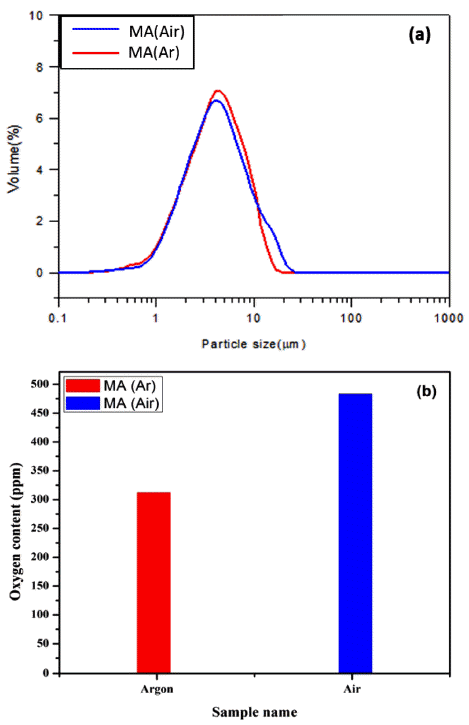


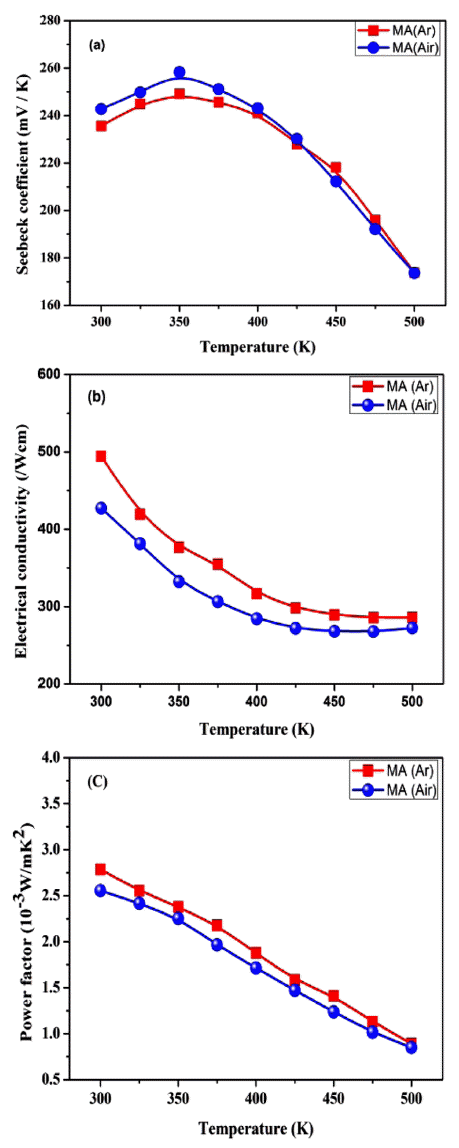

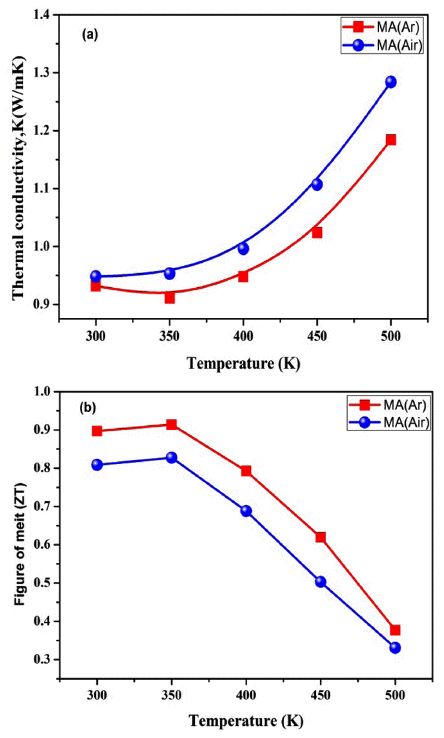
Fig. 1
The surface morphology of p-type Bi0.5Sb1.5Te3 alloy powder by mechanical alloying in (a) argon and (c) air atmospheres respectively. The figures (b), and (d) are the corresponding high magnification images.
Fig. 2
(a) Particle size distribution and (b) oxygen content analysis of the p-type Bi0.5Sb1.5Te3 alloy powder milled in argon and air atmospheres.
Fig. 3
X-ray diffraction patterns of p-type Bi0.5Sb1.5Te3 alloy powder milled in an argon and air atmospheres.
Fig. 4
EDS mapping showing the Bi, Sb, Te distribution and oxygen concentration of the p-type Bi0.5Sb1.5Te3 alloy powder milled in argon (a) and air (b) atmospheres.
Fig. 5
The temperature dependence of p-type Bi0.5Sb1.5Te3 alloys (a) Seebeck coefficient (b) Electrical conductivity and (c) Power factor of samples milled in the air and argon atmospheres.
Fig. 6
The temperature dependence of transport properties of (a) Carrier concentration and (b) mobility of P type Bi0.5Sb1.5Te3 bulk samples produced by MA and SPS
Fig. 7
The temperature dependence of (a) Thermal conductivity and (b) Figure of merit for p-type Bi0.5Sb1.5Te3 alloy powders were milled in an argon and air atmospheres.
Fig. 1
Fig. 2
Fig. 3
Fig. 4
Fig. 5
Fig. 6
Fig. 7
Influence of milling atmosphere on thermoelectric properties of p-type Bi-Sb-Te based alloys by mechanical alloying
| samples | Density (100%) | Vickers hardness (Hv) |
|---|---|---|
|
|
||
| Argon atmosphere (Ar) | 99.86 | 113 |
| Air atmosphere (Air) | 99.4 | 117 |
Table 1
Relative density and Vickers hardness of p-type Bi0.5Sb1.5Te3 alloy samples produced by MA and SPS
Table 1
TOP
 KPMI
KPMI


 Cite this Article
Cite this Article







